Replica Space Food
I had a minor knee injury last week, so between that and having my daughter over the weekend, I haven’t been able to do much construction work the past few days. I’m still doing design work on some details of the CM, and the 3D printer is continuously churning out parts, so I’m still moving forward on the Project, but during some of this down time I started experimenting with making replicas of some astronaut food items.
Accurate packaging is actually more difficult than the food itself. Real Apollo-era food packaging is horribly expensive. A single unused package of rehydratable Apollo food just went for $600 at auction a couple of weeks back!! There’s absolutely no way I could afford demonstrating that to school kids, much less hand some out to them. After much research and searching, I found some packaging that is close enough for educational purposes, and cheap enough to hand out. I ordered some samples, found them to be decent, then ordered a larger quantity of a few of them. After trying them out (as you’ll see below), I’ll be ordering some other sizes, too.
While my daughter and I were at the store, we discovered that they still make Tang. Tang, as you may or may not know, was the dehydrated substitute orange juice that was actually used on space missions until the NASA food labs were able to dehydrate real orange juice. Score one item! I also knew that Apollo astronauts had grape drink and tea available to them, so we also picked up some grape Kool-Aid and Lipton instant tea. My research revealed that these were packaged in 4 or 5 ounce servings, so I calculated what amount of dry stuff was needed for each, then put it into the long packages. The grape Kool-Aid needed sugar, and the tiny amount in the pouch was hard to measure, so I mixed a full recipe of powder and sugar, then measured out what I needed from there. Because the originals were folded for storage, I folded the packages before adding the mixes. I printed some replica labels on some return address labels and added them to the packages. The finished results look pretty good, if not completely authentic! They’re also about 30% smaller than the real thing, but that’s not very noticeable since the proportions are pretty much the same.
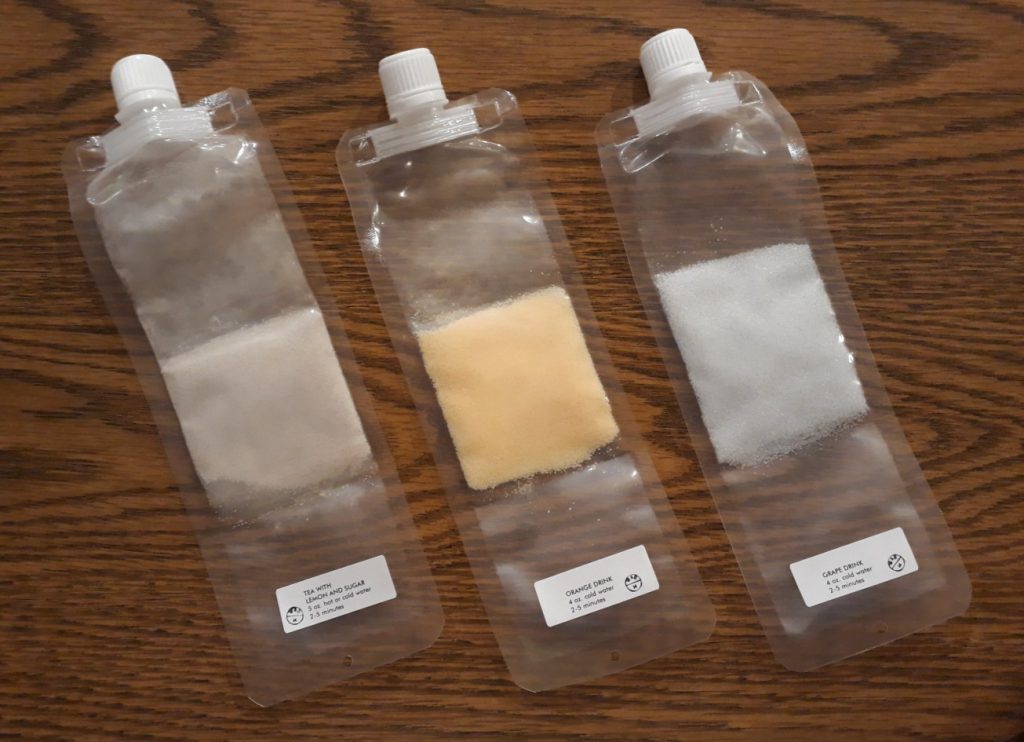
From left: Tea with Lemon and Sugar, Orange Drink, and Grape Drink.
(Photo: The Apollo Education Experience Project)
The earlier Apollo missions also had rehydratable food in the same long packages before the “spoon bowl” packaging was introduced. I didn’t have a whole lot of options here, but I did have one that would appeal to kids – chocolate pudding. I started with some instant pudding mix, but it requires milk to make, not just water. To turn this into a rehydratable item, I had to add instant milk as well. I got some nonfat dry milk, and from the instructions for one pouch I calculated how much of it and the pudding mix would be needed per ounce of water, then put the corresponding amount of dry ingredients into a package.
I also learned, through correspondence with a representative at Oregon Dry Foods (the original maker of many Apollo freeze-dried foods), that a few of their current line of Mountain House items are recipes that date to the Apollo era, such as Spaghetti, Beef Stew, and Rice and Chicken. It just so happens that I have some of them, including Beef Stew. A single-serving package of Beef Stew won’t fit in the smaller packages, so I divided it in two and put half in one of the packages. I put the other half into one of the sample packages I initially received (and had been experimenting on with the vacuum sealer), so I could try it out. It worked great! I made replica labels with the correct water amounts and times to reconstitute, and placed them on the packages.
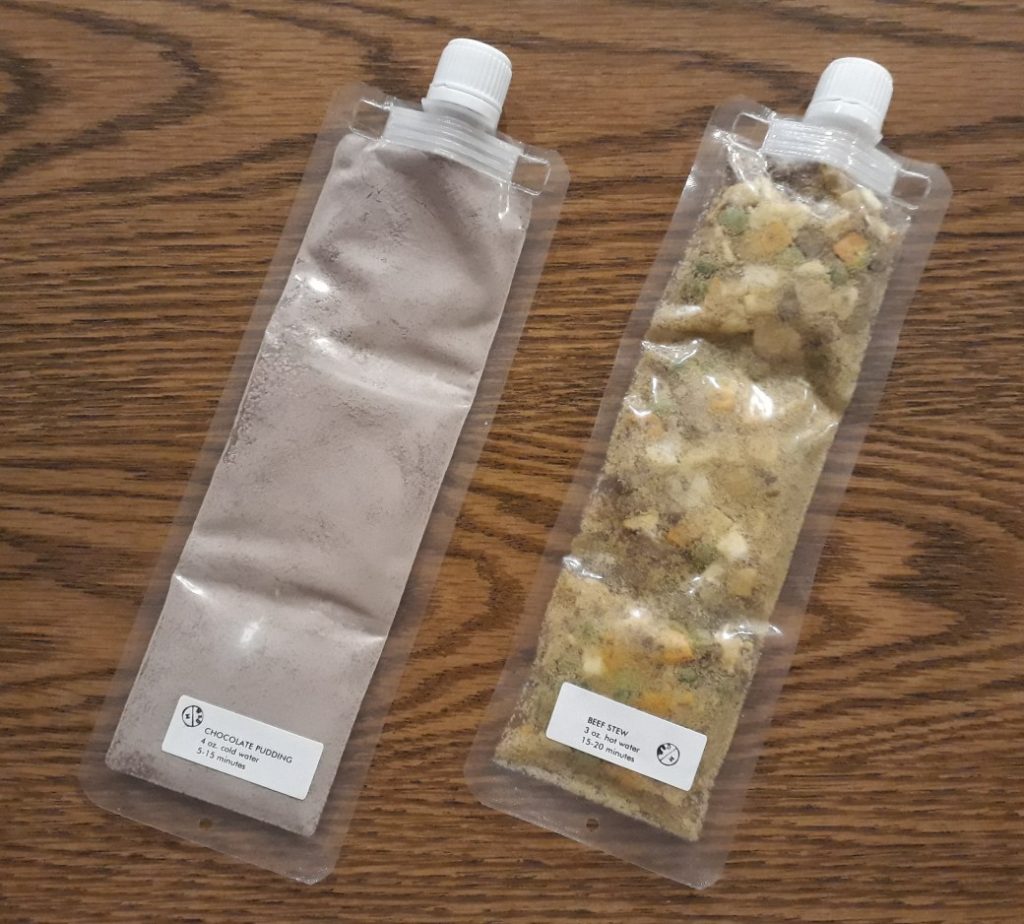
Chocolate Pudding (left) and Beef Stew (right)
(Photo: The Apollo Education Experience Project)
One of the samples I received was a small 1.75-ounce package with an angled opening that really resembled the “spoon bowl” packaging. I thought that the small size and interesting appearance ought to make these perfect samples for younger kids, so I ordered a number of these. And what better food item to give to kids than chocolate pudding! I had already calculated the amount of mix that would go with one ounce of water, so I prepared several of these using that amount and labeled them accordingly.
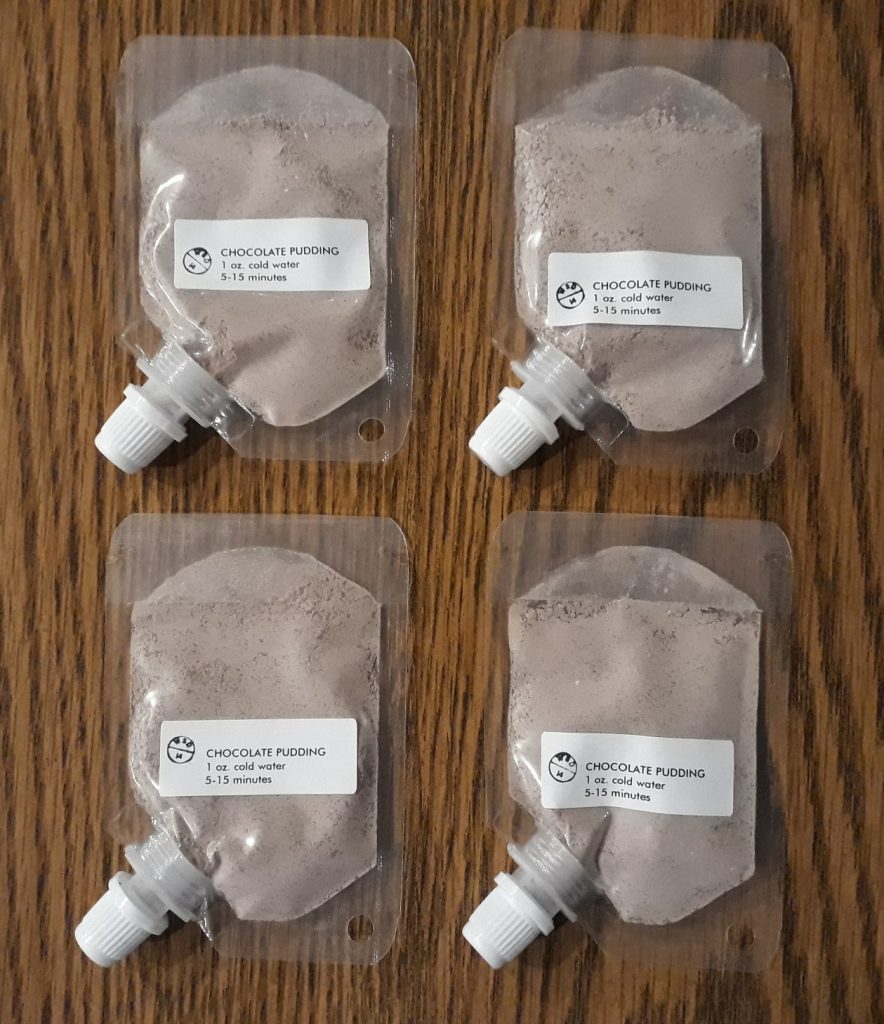
(Photo: The Apollo Education Experience Project)
The astronauts had more than just dehydrated foods and beverages available to them. Non-rehydratable foods fell into three categories: dry (no water at all), “intermediate moisture” (some water removed), and “natural form”. These were packaged in vacuum-sealed film. To make these, I came across a used FoodSaver vacuum sealer plus several rolls of film for an excellent price, then started scouting around for suitable foods.
One of the more recognizable forms of these foods were the food cubes, or “bites” as they were officially called. I’m still looking for ways to make these, but I was able to make “brownie bites” from some appropriately-named “cosmic brownies.” All “bites” were exactly 11/16″ per side, so I measured and cut four “bites” from the brownies for each package and sealed them up. I had to do some messing around with the film to get the packaging the right size, plus eliminate the printing along the edges of the film (which was DEFINITELY not accurate), but finally figured out how to make the replica packaging.
One of the more famous food items – and popular with the astronauts – were the “bacon bars.” These were made from bacon that was dried, chopped, and pressed into squares approximately 1-1/16″ per side. I could not make them that way, so I got some bacon jerkey, cut it to size, and sealed it. Another intermediate moisture item I made were dried apricots. I put six slices in a package and sealed them. And just for fun (and for my daughter), I made some natural-form food packages that would actually be shuttle-era instead of Apollo-era – pecan cookies and “candy coated chocolates.” NASA refused to give the impression of endorsing any of their contractors’ branding, so “M&Ms” were given a generic name!

Clockwise from top left: Brownie Bites, Bacon Bars (both Apollo-era), Pecan Cookies, and Candy Coated Chocolates (both shuttle-era).
(Photo: The Apollo Education Experience Project)
Now for kid testing! My daughter took a package of dried apricots and a package of “candy coated chocolates” to school as her snacks. When she got them out, she was instantly the center of attention, and was bombarded with questions from the other students … and her teacher!
We then rehydrated a couple of the drink packages at the house. I don’t (yet) have a water gun for rehydrating foods, so I measured the water in a measuring cup and we used a syringe to inject the water into the packages.
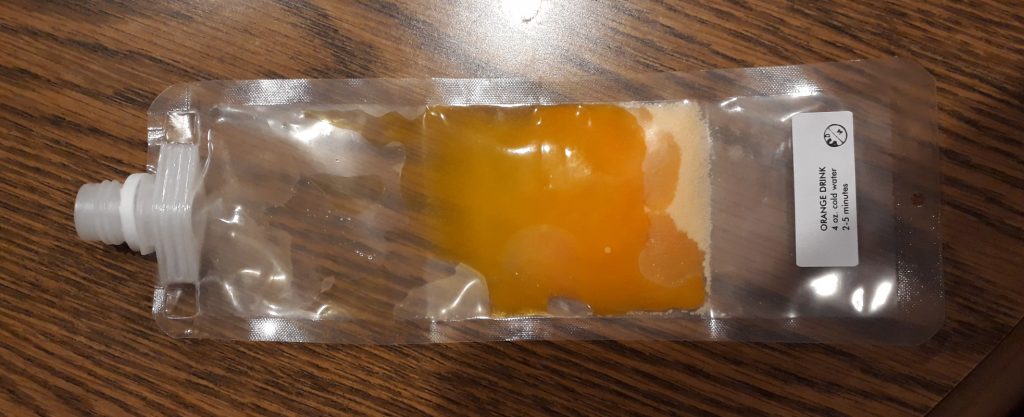
(Photo: The Apollo Education Experience Project)
After adding the water, we resealed the packages, kneaded and shook them to dissolved all the powder, then after the required time opened them and tried them out. Success! I’m glad we’re not in zero-G, though – drinking out of these packages isn’t as easy as you might think! Just sayin’ …

(Photo: The Apollo Education Experience Project)
Of course, my daughter would not go without trying the chocolate pudding, so we reconstituted a pair of the miniature packages. Unlike the drinks, these required several minutes to thicken after all the mix had been dissolved. Also, because of the lumpy nature of the dried milk, they needed a little extra kneading and pressing to help ensure all the small pieces were broken up and dissolved. But after the mixing and waiting, we got to try them out. We determined that they were worth the wait!

(Photo: The Apollo Education Experience Project)



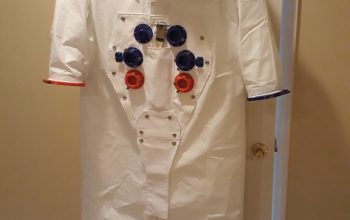
This is super! I’m also an Apollo nerd, and of that particular nerd subset, also a space food nerd. I’m doing a small 50th anniversary celebration for Apollo 17 and am planning on something rather similar to this. Would you be able to tell me where you got those Apollo-style packages? We had an Apollo 11 party on the fiftieth for that, and I wasn’t able to find anything similar to those, but I agree they’re about as close as I’ve seen commercially available.
Anyway, if you’d be so kind to let me know where you bought them from, I’d be most grateful.